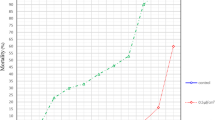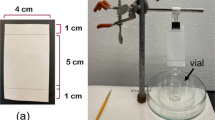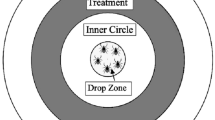Abstract
DEET and Eight commercially available essential oils (oregano, clove, thyme, vetiver, sandalwood, cinnamon, cedarwood, and peppermint) were evaluated for repellency against host-seeking nymphs of the lone star tick, Amblyomma americanum. Concentration-repellency response was established using the vertical paper bioassay technique for each essential oil and compared with that of N,N-diethyl-3-methyl benzamide (DEET), a standard repellent compound present in many commercial repellent formulations. The effective concentration of DEET that repels 50 % of ticks (EC50) was estimated at 0.02 mg/cm2, while EC50s of the essential oils fall between 0.113 and 0.297 mg/cm2. Based on EC50 estimates, oregano essential oil was the most effective among all essential oils tested, followed by clove, thyme, vetiver, sandalwood, cinnamon, cedarwood, and peppermint oils. None of the tested essential oils demonstrated a level of tick repellency found with DEET. Results from this study illustrated the challenge in search for more effective natural tick repellents.

Similar content being viewed by others
References
Barrett AW, Noden BH, Gruntmeir JM, Holland T, Mitcham JR, Martin JE, Johnson EM, Little SE (2015) County scale distribution of Amblyomma americanum (Ixodida: Ixodidae) in Oklahoma: addressing local deficits in tick maps based on passive reporting. J Med Entomol 52:269–273
Bissinger BW, Roe RM (2010) Tick repellents: past, present, and future. Pesti Biochem Physiol 96:63–79
Bissinger BW, Apperson CS, Sonenshine DE, Watson DW, Roe RM (2009) Efficacy of the new repellent BioUD against three species of ixodid ticks. Exp Appl Acarol 48:239–250
Bissinger BW, Schmidt JP, Owens JJ, Mitchell SM, Kennedy MK (2014) Activity of the plant-based repellent, TT-4302 against the ticks Amblyomma americanum, Dermacentor variabilis, Ixodes scapularis and Rhipicephalus sanguineus (Acari: Ixodidae). Exp Appl Acarol 62:105–113
Braverman Y, Chizov-Ginzburg A (1997) Repellency of synthetic and plant-derived preparations for Culicoides imicola. Med Vet Entomol 11:355–360
Carroll JF, Allen PC, Hill DE, Pound JM, Miller JA, George JE (2003) Control of Ixodes scapularis and Amblyomma americanum through use of ‘4-poster’ treatment device in Maryland. Exp Appl Acarol 28:289–296
Carroll JF, Cantrell CL, Klun JA, Kramer M (2007) Repellency of two terpenoid compounds isolated from Callicarpa americana (Lamiaceae) against Ixodes scapularis and Amblyomma americanum ticks. Exp Appl Acarol 41:215–224
Carroll JF, Pound JM, Miller JA, Matthew K (2009) Sustained control of Gibson Island, Maryland, populations of Ixodes scapularis and Amblyomma americanum (Acari: Ixodidae) by community-administered 4-poster deer self-treatment bait stations. Exp Appl Acarol 51:383–392
Carroll JF, Paluch G, Coats J, Kramer M (2010) Elemol and amyris oil repel the ticks Ixodes scapularis and Amblyomma americanum (Acari: Ixodidae) in laboratory bioassays. Exp Appl Acarol 51:383–392
Carroll JF, Tabanca N, Kramer M, Elejalde NM, Wedge DE, Bernier UR, Coy M, Becnel JJ, Demirci B, Baser KHC, Zhang J, Zhang S (2011) Essential oils of Cupressus funebris, Juniperus communis, and J. chinensis (Cupressaceae) as repellents against ticks (Acari: Ixodidae) and mosquitoes (Diptera: Culicidae) and as toxicants against mosquitoes. J Vector Ecol 36:258–268
Centers for Disease Control and Prevention (2004) Lyme disease—United States, 2001–2002. MMWR 53:365–369
Centers for Disease Control and Prevention (2013) Reported cases of Lyme disease by year, United States, 2003–2012. http://www.cdc.gov/lyme/stats/chartstables/casesbyyear.html
Childs JE, Paddock CD (2003) The ascendancy of Amblyomma americanum as a vector of pathogens affecting humans in the United States. Ann Rev Entomol 48:307–337
Cisak E, Wójcik-Fatla A, Zajac V, Dutkiewicz J (2012) Repellents and acaricides as personal protection measures in the prevention of tick-borne diseases. Ann Agric Environ Med 19:625–630
Dolan MC, Maupin GO, Schneider BS, Denatale C, Hammon N, Cole C, Zeidner NS, Stafford KC (2004) Control of immature Ixodes scapularis (Acari: Ixodidae) on reservoirs of Borrelia burgdorferi in a residential community in southeastern Connecticut. J Med Entomol 41:1043–1054
Eller FJ, Vander Meer RK, Behle RW, Flor-Weiler LB, Palmquist DE (2014) Bioactivity of cedarwood oil and cedrol against arthropod pests. Environ Entomol 43:762–766
Garboui SS, Jaenson TG, Borg-Karlson AK, Pålsson K (2007) Repellency of methyl jasmonate to Ixodes ricinus nymphs (Acari: Ixodidae). Exp Appl Acarol 42:209–215
Ginsberg HS, Ewing CP, O’Connell AF, Bosler EM, Daley JG, Sayre MW (1991) Increased population-densities of Amblyomma americanum (Acari, Ixodidae) on Long Island, New York. J Parasitol 77:493–495
Goddard J, Varela-Stokes AS (2009) Role of the lone star tick, Amblyomma americanum (L.), in human and animal diseases. Vet Parasitol 160:1–12
Gratz NG (1999) Emerging and resurging vector-borne disease. Ann Rev Entomol 44:51–75
Henderson G, Heumann DO, Laine RA, Maistrello L, Zhu BC, Chen F (2005) Extracts of vetiver oil as repellent and toxicant to ants, ticks, and cockroaches. US Patent #6,906,108
Hieu TT, Kim SI, Lee SG, Ahn YJ (2010) Repellency to Stomoxys calcitrans (Diptera: Muscidae) of plant essential oils alone or in combination with Calophyllum inophyllum nut oil. J Med Entomol 47:575–580
Jaenson TGT, Palsson K, Borg-Karlson AK (2005) Evaluation of extracts and oils of tick-repellent plants from Sweden. Med Vet Entomol 19:345–352
Jongejan F, Uilenberg G (2004) The global importance of ticks. Parasitology 129(Suppl):3–14
Jordan RA, Schulze TL, Dolan MC (2012) Efficacy of plant-derived and synthetic compounds on clothing as repellents against Ixodes scapularis and Amblyomma americanum (Acari: Ixodidae). J Med Entomol 49:101–106
Maistrello L, Henderson G, Laine RA (2001) Efficacy of vetiver oil and nootkatone as soil barriers against formosan subterranean termite (Isoptera: Rhinotermitidae). J Econ Entomol 94:1532–1537
Martinez-Velazquez M, Rosario-Cruz R, Castillo-Herrera G, Flores-Fernandez JM, Alvarez AH, Lugo-Cervantes E (2011) Acaricidal effect of essential oils from Lippia graveolens (Lamiales: Verbenaceae), Rosmarinus officinalis (Lamiales: Lamiaceae), and Allium sativum (Liliales: Liliaceae) against Rhipicephalus (Boophilus) microplus (Acari: Ixodidae). J Med Entomol 48:822–827
Mather TJ, Ribeiro JMC, Spielman A (1987) Lyme disease and babesiosis: acaricide focused on potentially infected ticks. Am J Trop Med Hyg 36:609–614
Mead P, Nelson C, Hinckley A, Hook S, Kugeler K, Perea A, Beard B (2013) Estimating the public health burden of Lyme disease in the United States. In: Proceedings of 13th international conference on lyme borreliosis and other tick-borne diseases, Boston, Massachusetts, August 18–21, 2013
Means RG, White DJ (1997) New distribution records of Amblyomma americanum (L.) (Acari: Ixodidae) in New York State. J Vector Ecol 22:133–145
Mehlhorn H, Schmal G, Schmidt J (2005) Extract of the seeds of the plant Vitex agnus castus proven to be highly efficacious as a repellent against ticks, fleas, mosquitoes and biting flies. Parasitol Res 95:363–365
Merten HA, Durden LA (2000) A state-by-state survey of ticks recorded from humans in the United States. J Vector Ecol 25:102–113
Parola P, Raoult D (2001) Ticks and tick-borne diseases in humans an emerging infectious threat. Clin Infect Dis 32:897–928
Perez de León AA, Teel PD, Li AY, Ponnusamy L, Roe RM (2014) Advancing integrated tick management to mitigate burden of tick-borne diseases. Outlooks Pest Manag 25:382–389
Piesman J, Eisen L (2008) Prevention of tick-borne diseases. Ann Rev Entomol 53:1–21
Pound JM, Miller JA, George JE, Fish D, Carroll JF, Schulze TR, Daniels TJ, Falco RC, Stafford KC, Mather TN (2009) The United States Department of Agriculture’s northeast area-wide tick control project—summary and conclusions. Vector Borne Zoonotic Dis 9:439–447
Reegan AD, Kannan RV, Paulraj MG, Ignacimuthu S (2014) Synergistic effects of essential oil-based cream formulations against Culex quinquefasciatus Say and Aedes aegypti L. (Diptera: Culicidae). J Asia Pac Entomol 17:327–331
Ritchie SA, Williams CR, Montgomery BL (2006) Field evaluation of New Mountain Sandalwood Mosquito Sticks and New Mountain Sandalwood Botanical Repellent against mosquitoes in North Queensland, Australia. J Am Mosq Control Assoc 22:158–160
Roh HS, Park KC, Park CG (2012) Repellent effect of santalol from sandalwood oil against Tetranychus urticae (Acari: Tetranychidae). J Econ Entomol 105:379–385
Sathantriphop S, White SA, Achee NL, Sanguanpong U, Chareonviriyaphap T (2014) Behavioral responses of Aedes aegypti, Aedes albopictus, Culex quinquefasciatus, and Anopheles minimus against various synthetic and natural repellent compounds. J Vector Ecol 39:328–339
Schulze TL, Jordan RA, Schulze CJ, Mixson T, Papero M (2005) Relative encounter frequencies and prevalence of selected Borrelia, Ehrlichia, and Anaplasma infections in Amblyomma americanum and Ixodes scapularis (Acari: Ixodidae) ticks from central New Jersey. J Med Entomol 42:450–456
Schwantes U, Dautel H, Jung G (2008) Prevention of infectious tick-borne diseases in humans: comparative studies of the repellency of different dodecanoic acidformulations against Ixodes ricinus ticks (Acari: Ixodidae). Parasit Vectors 1:8
Shapiro R (2012) Prevention of vector transmitted diseases with clove oil insect repellent. J Pediatr Nurs 27:346–349
Sonenshine DE, Roe RM (2014) Biology of ticks, 2nd edn. Oxford University Press, New York
Springer YP, Eisen L, Beati L, James AM, Eisen RJ (2014) Spatial distribution of counties in the continental United States with records of occurrence of Amblyomma americanum (Ixodida: Ixodidae). J Med Entomol 51:342–351
Thorsell W, Mikiver A, Tunon H (2006) Repelling properties of some plant materials on the tick Ixodes ricinus L. Phytomedicine 13:132–134
Vaughn MF, Meshnick SR (2011) Pilot study assessing the effectiveness of long-lasting permethrin-impregnated clothing for the prevention of tick bites. Vector Borne Zoonotic Dis 11:869–875
Vucinic M, Nedeljkovic-Trailovic J, Trailovic S, Ivanovic S, Milovanovic M, Krnjaic D (2011) Carvacrol importance in veterinary and human medicine as ecologic insecticide and acaricide. Vet Glas 65:433–441
Acknowledgments
The authors wish to thank James McCrary of USDA, ARS, Invasive Insect Biocontrol and Behavior Laboratory (IIBBL) for technical support, and Dr. Erika Machtinger (USDA, ARS, IIBBL) for critical review of the manuscript. H. Meng was supported by a scholarship from China Scholarship Council; LM Costa Junior was supported by a Grant from the Science Without Borders Program of CAPES, a Foundation affiliated with the Ministry of Education of Brazil; and AY Li was supported by funds from an ARS in-house Project (#8042-32000-008-00)—Prevention of Arthropod Bites.
Author information
Authors and Affiliations
Corresponding author
Additional information
This article reports the results of research only. Mention of a proprietary product does not constitute an endorsement or a recommendation by the USDA for its use. The USDA is an equal opportunity provider and employer.
Rights and permissions
About this article
Cite this article
Meng, H., Li, A.Y., Costa Junior, L.M. et al. Evaluation of DEET and eight essential oils for repellency against nymphs of the lone star tick, Amblyomma americanum (Acari: Ixodidae). Exp Appl Acarol 68, 241–249 (2016). https://doi.org/10.1007/s10493-015-9994-0
Received:
Accepted:
Published:
Issue Date:
DOI: https://doi.org/10.1007/s10493-015-9994-0




